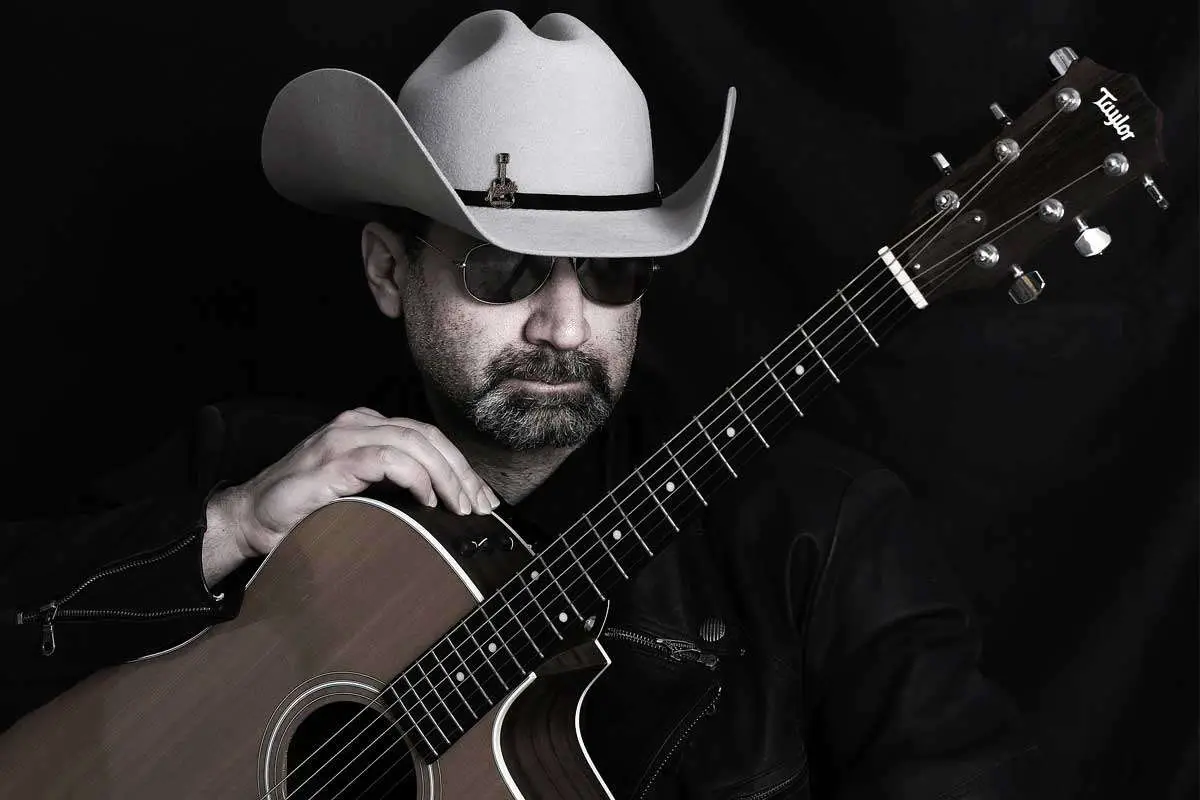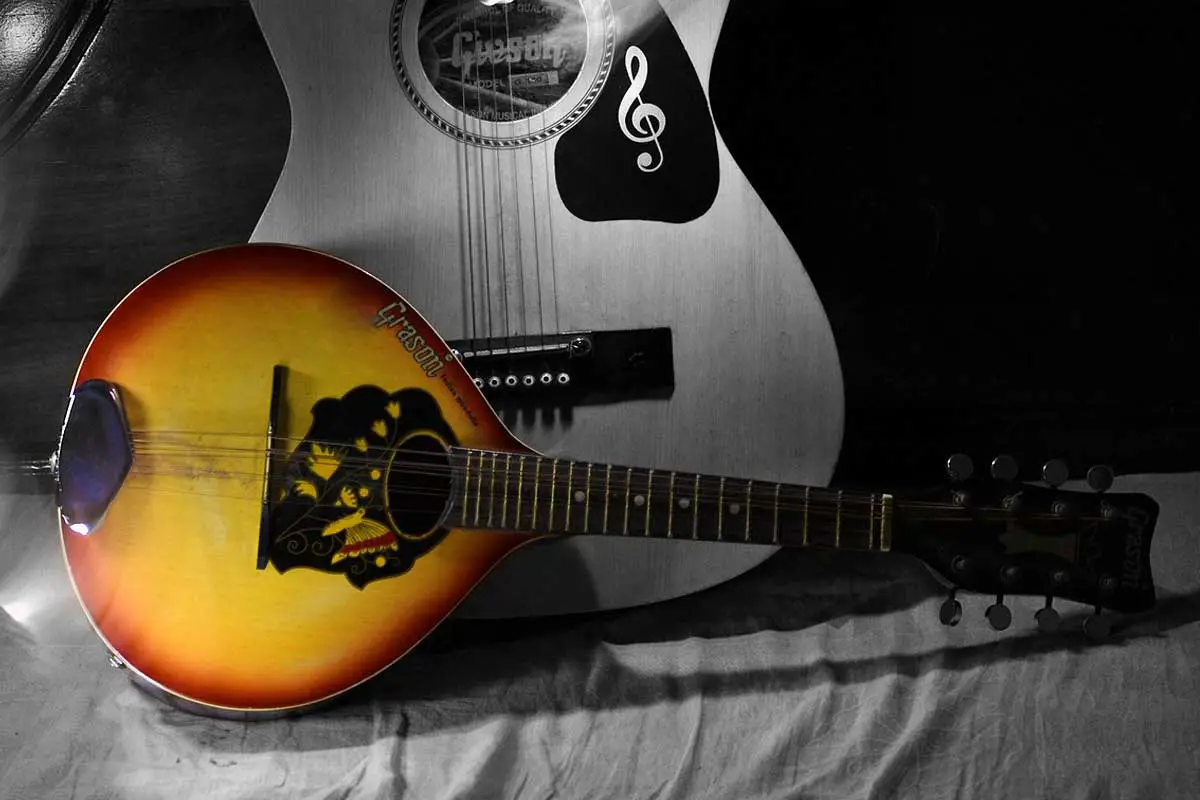When it comes to Nashville tuning for guitar, it’s essentially a method for tuning a six string guitar in a way that mimics the sparkling chime of a twelve string guitar.
This method involves replacing the four lowest strings with lighter gauge strings and tuning them up an octave higher than standard tuning, leaving the two highest strings at their usual octave. This results in an exciting sound rich in harmonics and brightness, which can bring new life to guitar arrangements.
Nashville tuning is often used in the studio for doubling guitar tracks, providing an extra layer of high-frequency sparkle that can make your music stand out. This alternate tuning is popular in country music but has also been adopted in rock, pop, and folk genres.
Nashville tuning is a creative & inspiring alternative guitar tuning that can provide a fresh perspective to your playing. In this article we cover the benefits, how to do it, what strings to use, and famous artists who have used this tuning in the past.

Benefits of Nashville Tuning
Nashville tuning provides an excellent way to broaden your guitar skillset and enhance the quality of your music. By exploring this unique tuning, you can discover fresh ideas and unlock new creative possibilities in your songwriting.
One significant benefit is the clarity it offers, particularly on acoustic guitars. Since the four lowest strings (E, A, D, and G) are tuned up an octave, their pitch becomes considerably higher, resulting in a crisp and bright tonal quality. When you experiment with this tuning, you’ll notice that your guitar chords ring out with a sparkling resonance, cutting through the mix with ease.
Another advantage is its distinctive chime-like sound. This ethereal quality can add a touch of magic to your songs, transforming everyday chord progressions into something truly mesmerizing. The shimmering effect brought about by the higher string octaves is especially useful for creating lush soundscapes, as it gives your melodies an almost harp-like texture.
Nashville tuning can also be a valuable tool for songwriting. By changing up the way your guitar is tuned, you’ll naturally approach the instrument differently, potentially unlocking new ideas and breaking through creative barriers. Composing songs using this tuning can lead to fresh chord voicings and unexpected melodic patterns that you might not have otherwise discovered.
Finally, it encourages creativity and experimentation. As a guitarist, it’s essential to continually evolve and explore new sounds and techniques. Diving into the world of Nashville or High Strung tuning not only expands your musical palette, but it can also help you grow as an artist and gain a deeper understanding of your instrument.

How To Nashville Tune A Guitar
Nashville tuning, also known as high-strung tuning, creates a unique chiming sound, commonly used in country music.
To set up your guitar for Nashville tuning, you will need a special set of guitars strings. These specialized guitar strings are much thinner than a normal set but are installed & tuned in much the same way as a regular guitar. Below are the reference pitches for each of the open guitar strings:
Choosing the Right Strings
When it comes to “high strung” tuning, selecting the right strings is crucial to achieving that unique, chiming sound. This tuning requires you to use lighter gauge strings on the lower four strings, compared to traditional guitar tuning. Keep in mind that old strings may not produce the desired result due to their reduced resonance, so always opt for a full set of new strings.
The strings we recommend for Nashville tuning are the D’addario EJ3H for acoustic guitar or the D’addario EXL150H for electric guitars.
By using these specific gauges, your guitar will maintain a balanced tension across the strings, ensuring optimal playability and sound. You may also choose to experiment with different string materials and brands, as they can contribute to unique tonal characteristics.
Remember that regular maintenance of your strings is crucial to maintaining the sparkle and clarity of this tuning. Keep your strings clean and replace them regularly to achieve the best results.

Nashville Tuning and Famous Musicians
Pink Floyd
Nashville tuning is widely recognized in many popular songs over the years, including some from iconic rock bands. Pink Floyd is one notable example, as guitarist David Gilmour used High Strung tuning in the song “Hey You.” This high strung guitar sound helped create the ethereal and delicate tones that contributed to the unique soundscape for which Pink Floyd is renowned.
Rolling Stones
The Rolling Stones also made use of High Strung tuning in their classic track “Wild Horses.” This technique was perfect for achieving a richer, jangly sound that complemented the song’s introspective mood. By incorporating this tuning, the Rolling Stones managed to evoke a sense of longing and melancholy with their guitar work, adding depth to the composition.
Other Notable Musicians
Several other musicians and bands have utilized Nashville tuning in their work, creating memorable and distinct sounds. For instance:
- Rush: The progressive rock band Rush used it on some of their albums, showcasing their versatility and willingness to explore alternative performance practices.
- Kansas: The song “Dust in the Wind” by Kansas stands out as one of the most famous examples of Nashville tuning. The song’s iconic acoustic guitar part relies on the ringing, harp-like quality inherent to the tuning.
- Elliott Smith: The critically acclaimed singer-songwriter Elliott Smith extensively used Nashville tuning on his album “XO.” The unique texture it provides helped Smith convey a range of emotions through his music.
- Pat Metheny: Esteemed jazz guitarist Pat Metheny employed the tuning on his track “Phase Dance.” The alternate tuning adds an extra layer of vitality to the performance, highlighting Metheny’s innovative approach to guitar playing.
- The Headmaster Ritual: The alternative rock band The Headmaster Ritual also used the tuning to create a brighter and more open sound, as can be heard in their music.

Comparison with Other Instruments
When exploring Nashville tuning for guitar, it’s essential to compare its unique sound and characteristics with other stringed instruments. This will give you a better understanding of its versatility and potential applications in music making.
Firstly, Nashville tuning resembles the sound of a mandolin due to its high pitch and chiming timbre. While both instruments share similar high-pitched tones, it’s important to note that the mandolin has its own distinct tuning and typically has eight strings. On the other hand, Nashville tuned guitars maintain the standard six-string configuration, albeit with thinner strings and different tuning.
In comparison to a an actual 12 string guitar, a Nashville tuned guitar retains a unique, jangly sound. A 12-string guitar has octave pairs on the low E, A, D, and G strings and unison pairs on the B and high E strings. However, the six string guitar focuses on only the higher-pitched octave strings for a lighter, more airy sound. While the 12 string guitar provides a fuller and richer tone, the six string guitar stands out for its higher register and brighter sound.
When it comes to acoustic guitars, a standard tuned guitar will be optimized for strumming & fingerpicking techniques. The natural resonance of the wooden body amplifies the strings’ sound, creating a warm and full tone. A high strung guitar, on the other hand, emphasizes the higher octaves, which can create a harmonic sparkle when played alongside a traditionally tuned acoustic guitar. This combination is especially popular in country music and recording sessions to add depth and texture to the guitar tracks.
Lastly, the electric guitar offers a unique playground for Nashville tuning. The electric guitar’s pickups and amplification system can produce a wide range of tonal qualities and effects. Nashville tuning on an electric guitar can achieve mandolin-like sound or sparkling arpeggios that can complement or contrast with other guitar parts in the mix. This versatility in sound makes the tuning an excellent choice for experimenting with various guitar effects and layering techniques.
Related: How to tune a 12 string guitar
Frequently Asked Questions
What are the best strings for Nashville Tuning?
When choosing strings for Nashville Tuning, it’s crucial to pick a set designed specifically for this tuning. The ones we recommend are the D’Addario EJ3H (acoustic guitar) or the EXL150H (electric guitars)
What are some famous songs using Nashville Tuning?
The Nashville tuned guitar has been featured in numerous popular songs, showcasing its versatility and unique sound. Some famous examples include “Hey You” by Pink Floyd, “Wild Horses” by The Rolling Stones, and “The Boxer” by Simon & Garfunkel. This tuning adds a distinctive shimmer and depth to the guitar sound, making it a popular choice for recording sessions.
How do Nashville Tuning chords differ from standard tuning?
Nashville Tuning looks similar to standard tuning, but since the lower strings are replaced with their higher octave counterparts, chord shapes will sound different. The higher octave strings create a jangly sound and can add a sparkling brightness when played with a regular guitar. However, traditional chord shapes and fingerings remain the same, making it easy for guitar players to adapt to this tuning.
Can Nashville Tuning be applied to an electric guitar?
Yes, a Nashville Tuning sound can be used on electric guitars just as effectively as on acoustic guitars. While the technique originated with acoustic guitars, many electric guitar players have embraced it for its unique sound and added tonal depth. Simply replace the lower four strings with their higher octave counterparts, and you’re good to go.
